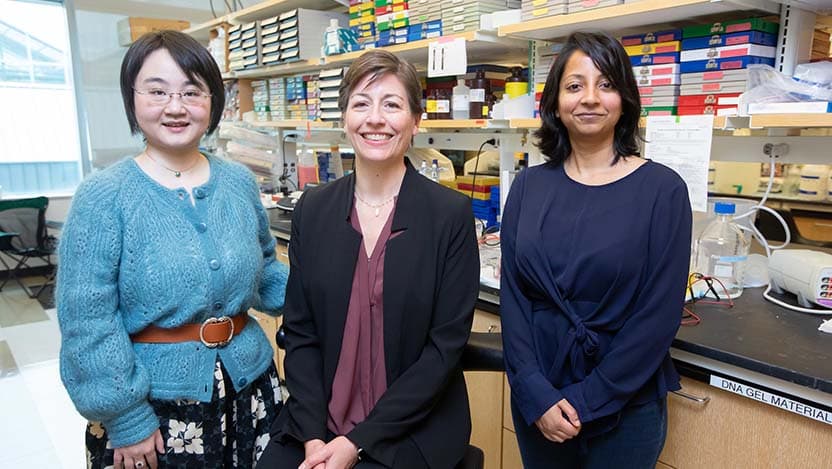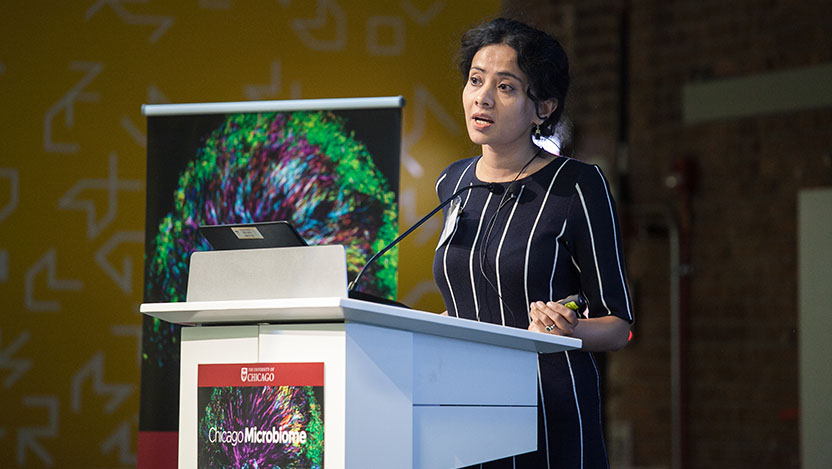Women's History Month: Scientists making history in human genetics research

Mengjie Chen, PhD (left), Megan McNerney, MD, PhD (center), Maanasa Raghavan, PhD (right), and Anindita Basu, PhD (not pictured), are working at the leading edge of human genetics research.
Despite decades of messaging that “STEM is for boys,” the proportion of women in science, technology, engineering and mathematics continues to rise. Today, women earn more than half of all PhDs in the biological sciences in the U.S.
Women in STEM juggle career goals, family and social expectations, while navigating the obstacles presented by systemic bias and an increasingly competitive job market. During the past two years, they’ve also confronted challenges of conducting research during a global pandemic. Despite these hurdles, many women find careers in STEM highly rewarding and view them as opportunities to bring fresh perspectives and new ideas to their fields.
At the University of Chicago, four human genetics faculty members are making waves with their research, developing new tools and techniques to understand the molecular underpinnings of disease and incorporate more inclusive approaches to the field.
Mengjie Chen, PhD, Assistant Professor, Departments of Medicine and Human Genetics
Research focus: Developing new technologies for high-throughput single-cell analysis, measuring gene or protein expression at the single-cell level. This work has applications for cancer, where understanding intratumor heterogeneity can be key for identifying ideal treatment approaches, and neuroscience, where understanding differences between individual cells can help us better understand the structure and composition of the brain.
Favorite part of her job: Reviewing a data set and discovering something that hasn’t been noticed by other people yet. “We can see something entirely new, a new phenomenon from the data, and try to explain why we’re seeing this,” Chen said.
A surprising aspect about her experience in STEM: Initially, Chen was discouraged by the prospects of a career in academic research as she watched mentors juggle large labs, administrative work and conference travel. “After becoming an assistant professor myself, I realized that not every faculty member will lead a life like that,” Chen said. “You can lead a very balanced life. I chose this job for the flexibility of being able to study anything I wanted.”
What do you wish more people knew about your work? Just because there is no immediate clinical or translational application doesn’t mean that the work isn’t relevant or useful. “We don’t have many opportunities to be introduced to the general public, because a lot of the research is only loosely related to disease treatment,” Chen said. “We need more opportunities to talk to younger generations if we want to attract more students and to help the general public learn about the existence of this field. It’s not highlighted often, but it’s very important.”
Megan McNerney, MD, PhD, Associate Professor, Department of Pathology
Research focus: Studying how and why some patients respond well to treatment while others do not in blood cancers, specifically myeloid malignancies. A large focus is on understanding why high-risk patients, who don’t respond to treatment, are frequently missing a portion of chromosome 7 in their tumor cells, and how that leads to treatment resistance. Her research has identified a gene called CUX1 on chromosome 7 that acts as a “master regulator” of the genome; if you remove this gene in mice, they develop myeloid malignancies.
What’s the most exciting thing happening in the field right now? “Next-generation sequencing and uncovering somatic mutations that occur in cancer have opened up the door for finding new tailored therapies for cancer,” McNerney said. Instead of using systemic chemotherapy for all cancers, which targets all proliferating cells in the body, personalized inhibitor treatments are based on specific mutations in cancerous tumors. “This is a super-fun time to be in cancer research,” McNerney said. “We have these specific drugs we can give patients, the outcomes are better, patients feel better, and it’s less toxic.”
Favorite part of her job: “I’m interacting with smart, creative, motivated people who are inspiring and engaging, and it’s very intellectually stimulating. Even if I won the lottery, I would keep my job.”
What advice do you have for women in STEM? “Learning to say no is key. Women often get stuck with the so-called ‘pink labor,’ and in science, it’s still a huge problem. As women in leadership positions, we need to foster an environment where we’re enabling our junior investigators to thrive and stay focused on their priorities.”
Maanasa Raghavan, PhD, Assistant Professor, Department of Human Genetic
Research focus: Reconstructing human population and demographic history in order to understand the origins, past migratory patterns, and adaptive and disease trajectories of different populations worldwide. “We all have a shared history leading back to Africa, but since the migration out of Africa between 60,000 and 100,000 years ago, unique cultural, societal and biological evolutionary processes have caused different populations around the world to drive in unique directions,” Raghavan said. Her team is not only seeking to understand the biocultural trajectories that have shaped our human species, but also to diversify the genomic literature in a sustainable and equitable fashion, working with Indigenous communities to better understand their histories, build community partnerships for sequencing diverse populations of people, and help build and support scientific capacity in collaborating countries.
What’s the most exciting thing happening in the field right now? “In the last 10 years, there’s been a revolution with the advent of next-generation sequencing techniques. Coupled with that has been the development of methods to generate large genomic data sets from ancient samples. We’ve learned that human populations have mixed around a lot in the past. It’s hard to look around today and find a ‘pure’ population. We now have exciting new avenues to explore these questions that are already well-studied in some regions, like Europe, and start taking that to more underrepresented populations. Increasing representation in genomic data sets will bring forth new insights and create opportunities to work collaboratively with communities and their existing knowledge.”
Favorite part of her job: The opportunity to explore new, never-before-asked research questions, and being able to work with the next generation of scientists. “Postdocs and students become your colleagues, and you’re all working together as a team. We’re all sharing this knowledge and process of learning and teaching — it’s not just one way.”
What do you wish more people knew about your work? Raghavan said she struggles with the conflation between genetics and race in ways that are not biologically or scientifically supported. “Sometimes papers get misinterpreted or data get used in nefarious ways by people with an agenda,” she said. “We can’t expect people to pick up a paper and understand the jargon. With social media and the power for scientists to be more visible, it’s up to us to simplify our science.”
Anindita “Oni” Basu, PhD, Assistant Professor, Department of Medicine
Research focus: Basu has combined innovative droplet technology with genetic sequencing technology to develop high-throughput methods for single-cell sequencing, a technique called Drop-Seq. While many commercial platforms have been developed for this type of analysis, Basu describes hers as “home-brewed” and “open source,” and her team is working on expanding the technology to biological systems that have not been easily accessed by existing systems.

What’s the most exciting thing happening in the field right now? “In single-cell genomics, we mainly look at RNA, or gene transcription. But there are new techniques coming in that look at epigenetics, which affect how genes and their functions are regulated. This provides information on how gene regulation might be different among different populations. We are seeing some indications that we can understand disease from a population perspective, which is valuable for medical applications and also for understanding how our genomes might make us more susceptible to different conditions.”
Favorite part of her job: “I really enjoy collaborative research. I love to work with all of these interesting scientists who think in different ways, and getting to see things from their perspective.”
Something surprising about her experience in STEM: How exciting the field can be, and how quickly progress can be made. “I came to systems biology in a roundabout way,” Basu said. “I thought I was going to be an engineer and got into physics and then into systems biology because I enjoyed it so much. It’s been a very honeymoon experience. Not to say that physics is not exciting, but it’s a very old field, and the new findings that come out tend to be incremental. In genetics, it’s like a child going to the fair. There are so many exciting things happening, and we’re finding big and bold insights because the field is so new. That’s not a given for all fields."
